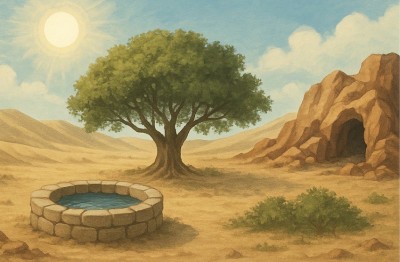
In his bestseller The Bible As History (Bantam, 1983), author Werner Keller observes that besides its profound spiritual and ethical dimensions, the Tanach also holds tremendous practical value. A compelling example of this can be found in Parshat Vayeira—and not only there.
Since the founding of the modern State of Israel in 1948, the Tanach has served as a trusted source of insight in the country’s development. Although written over 3,300 years ago, the Torah provides practical, real-world guidance for agriculture, settlement, and infrastructure in Eretz Yisrael.
Take the Negev, for example. South of the Judean Hills, stretching from Chevron to Egypt, lies a vast desert that receives less than six inches of rain annually. At Israel’s founding, settling this arid region seemed unthinkable.
But our parshah tells us:
“Avraham traveled from there to the land of the south, and he dwelt between Kadesh and between Shur, and he sojourned in Gerar” (Bereishit 20:1).
The Torah describes Avraham engaging in cattle breeding in this desert region. How did he manage without water?
Later in Parshat Toldot, we find the answer: “And Yitzchak again dug the wells of water that had been dug in the days of his father, Avraham…” (Bereishit 26:18).
Modern Israeli geologists, inspired by this verse, explored the Negev—and found a well of potable spring water. To this day, it continues to serve around 60 families not far from Beersheva.
Another practical application drawn from our parshah was posed by early Israeli agricultural planners: “What tree can possibly take root in the Negev?” Yosef Weitz (1890–1972), a pioneer of the Jewish National Fund (JNF), famously replied: “The eishel tree planted by Avraham in Beersheva.” Following his lead, the JNF ultimately planted over two million trees in the Negev.
And there’s more. As Professor Zagari of Hebrew University noted, “Trees grow better where they once grew.” When the Tribes of Ephraim and Menashe complained to Yehoshua about their small territorial allotment, he advised them: “Go and cut down the forest” (Yehoshua 17:14–18). From here we learn that forests once stood in that region—and if they stood once, they can grow again.
The Torah even guided Israel’s mining industry. In Devarim (8:9), the Land is described as:
“…a land whose stones are iron and out of whose mountains you will hew copper.”
Sure enough, copper mines were discovered in the Negev’s Timna region in the 1930s. These mines date back to the era of Shlomo HaMelech and now form the heart of Timna National Park.
The eternal words of Torah are not only the soul of the Jewish people—they are also the blueprint of our return to the Land.
Parashat Vayeira is sponsored by Alexandr & Lara Mashkevich
Rabbi Yitzchok Zilber, ztk”l, was the founder of LaMaalot Foundation. He dedicated his life to teaching Torah, and his impactful writings continue to inspire Jews worldwide. Copyright 2023 by The LaMaalot Foundation. Conversations on the Torah, by Rabbi Yitzchak Zilber is catalogued at The Library of Congress. All rights reserved. www.LaMaalot.org
Parshat Vayeira: Timeless Wisdom, Timeless Land
Typography
- Smaller Small Medium Big Bigger
- Default Helvetica Segoe Georgia Times
- Reading Mode




